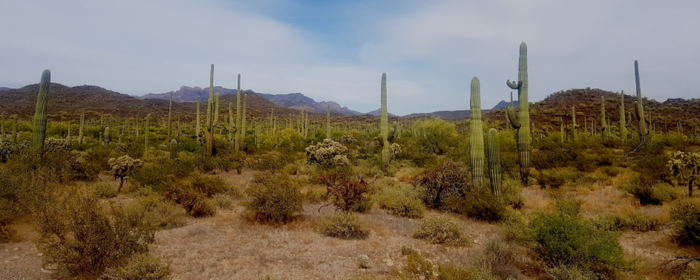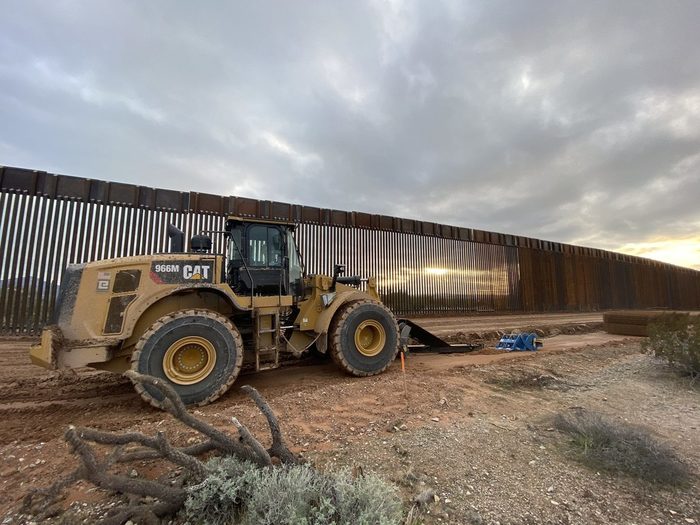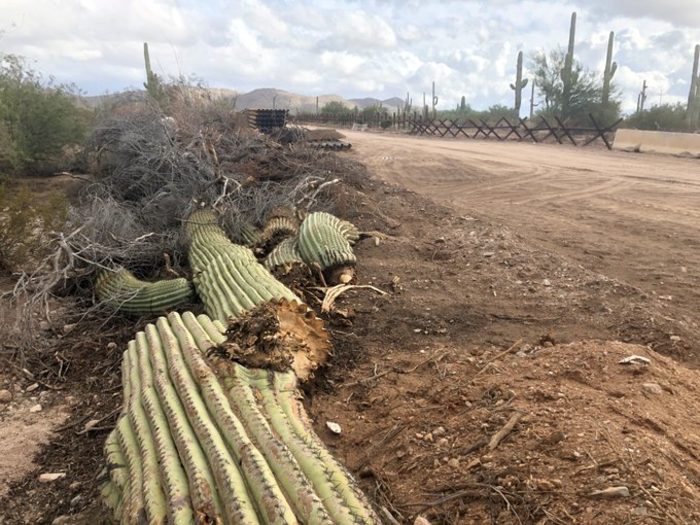By Sofia Ababou

The Organ Pipe Cactus National Monument (transborder park - Photo credits : Sofia Ababou and Thalia D'Aragon-Giguère)
Over the past few months, the United States government has pledged to build or replace nearly 800 kilometers of wall on the United-States-Mexico border by the end of the year at a cost of nearly 20 billion dollars. As the wall has drastic consequences on local wildlife and after four years of climate skepticism in the White House, environmental activists in the region are celebrating Joe Biden's victory after a tight race with the sitting president. But the Trump administration has already completed nearly 750 kilometers of wall so far, which will permanently scar the border region ecosystems and its communities.
Dan Millis, director of the Sierra Club Grand Canyon chapter’s border program, reported that the stretches of wall erected in 2020 are five times more costly than the old fences. That mountains, some of which are sacred indigenous sites, have been blasted out. That walls have been built on rivers : as over the San Pedro river in Arizona. And that this is senseless, counterproductive, and harmful - to border communities as well as to biodiversity.
Despite a considerable increase of aggressive migration policies under the Trump administration, the hardening of border policies, including the construction of border walls, is not a recent phenomenon in the United-States. Dan Millis and the local Sierra Club, in collaboration with other environmental organizations and the American Civil Liberties Union (ACLU) have been fighting them for years and asking for a change of tone from Washington.
For several decades, the political discourse on the United-States-Mexico border zone has been set on drug trafficking, undocumented immigration, terrorism (since 2001), or more recently, Trump’s wall. But to many residents of the region, the patchwork of landscapes that make up the southern border holds a very different symbolic meaning.
Stretching 3155 kilometers from the Pacific to the Gulf of Mexico, the border line crosses through six ecosystems and presents a wide variety of landscapes such as deserts, rivers, mountains, forests or meadows. Thousands of animal and plant species live alongside each other in these unique natural habitats, some of which are very ancient: an 11 700-year-old creosote tree discovered in the Lucerne Valley in California is one of the oldest plants in the world. In southern Arizona, the Tohono O'odham indigenous Nation’s ancestral territory stretches across the border with Mexico and is home to numerous sacred sites such as the Baboquivari Mountain. In the eastern part of the country, on the banks of the Rio Grande lies the National Butterfly Center, a vital haven for the famous endangered Monarch butterfly, but also for Texas lynx, coyotes, armadillos and turtles. The Rio Grande straddles Mexico on more than 3000 kilometers and has deeply influenced collective imaginary by its singularity and the diversity of its landscapes. It is also one of the main water sources in the area, crucial and vital for many border communities due to the region’s near-desert climate.
In order to protect these natural environments, countless parks have been established throughout the country and millions of tourists flow through them each year. Yet, despite years of struggles to protect endangered local biodiversity, the construction of the border wall has greatly weakened these pristine ecosystems. And has undermined a hundred years of efforts to promote environmental conservation.

Border wall construction in Organ Pipe Cactus National Monument (2020 - Photo credits: Laiken Jordahl)
“Living and working along the U.S.-Mexico border has meant watching the surreal, slow-motion leveling of the fragile ecosystems I’ve spent my career fighting to protect” writes Laiken Jordahl, borderland campaigner at the Center for Biological Diversity in Tucson, Arizona, referring to the construction of the wall.
Spearheading Donald Trump’s first election campaign, the construction of a wall between the United States and Mexico was at the epicenter of public debate throughout his entire presidency. Yet, before he came to power, walls and barriers already existed along about one-third of the border.
“Normally local, state, and federal environmental laws would protect the borderlands from this kind of industrial-scale destruction and allow local communities a say in new federal projects”, writes Laiken Jordahl about the disruption of fragile ecosystems, underground water drainage and the destruction of pristine natural habitats for the sake of the border wall. But in 2005, Congress passed the REAL ID Act, which empowers the Secretary of Homeland Security (DHS) to waive any law that could prevent the construction of walls and roads along national borders.
In 2008, two million cubic meters of soil were dumped at Smuggler's Gulch, in southern California. This gigantic canyon is located only a few kilometers away from the Pacific Ocean and borders the estuary of the Tijuana River, a wildlife refuge to several hundred endangered bird species. While the Coastal Commission had raised concerns about the risks of such a construction plan in the early 2000s, the adoption of the REAL ID Act allowed the Department of Homeland Security to move forward with the project without having to comply with environmental regulations.
For decades, Mike Mc Coy has worked to restore the Tijuana River estuary: "We are seeing a lot of erosion right here. The river carries sediment to the estuary, and if that tidal coastal zone fills with sediment, native plants and animals won't be able to survive. It adds up to disaster” he says.
Since 2005, countless legislations have been lifted one after the other in order to speed up border wall construction, flouting numerous existing environmental laws. These include, among others, the Endangered Species act, the Clean Air and Water acts, and the Native American Graves Protection and Repatriation Act.
According to the Congressional Research Service, the authority that has been granted to the Secretary of Homeland Security to circumvent any domestic legislations is the most far-reaching ever that have been issued in the country's history. Criticized, challenged and dismissed as unconstitutional, the REAL ID Act was declared not to infringe on the separation of powers, according to a Supreme Court ruling that followed a legal standoff with the Sierra Club and the Defenders of Wildlife in 2008.
Since 2016, the Trump administration has waived nearly 50 laws in order to deliver on its campaign promise. And for the first time ever since the REAL ID was passed, the government has also announced a few months earlier its intention to waive more than 10 federal contracting laws, which provide transparency in the handling of government contracts with private companies regarding public infrastructure projects.
These waivers contribute to eroding public trust in the government, according to many local associations that are advocating against the construction of the border wall. Especially because one of the private companies that was selected by the Trump administration to undertake the pursuit of the construction, Fisher Sand and Gravel, has recently received funds from “We Build the Wall” in order to complete the construction of two walls on a private land in South Texas. This alt-right organization had made a polemic claim stating that the government was not moving fast enough to fulfill its campaign promise and that they could build it faster.
The reason why these exemptions are troubling is because We Build the Wall is led by Steve Bannon, former advisor to President Trump and a leading figure of the right-wing movement in Europe... who was arrested last July and charged with funneling hundreds of thousands of dollars from an online fundraising campaign that was destined for We Build the Wall (finally pardoned by President Trump on January 20).
This lack of transparency is a great concern for many local associations, such as the Sierra Club, which have been campaigning for decades to address the implications of the wall on the borderland's fragile ecosystems.
While January's presidential elections resulted in renewed optimism in border communities (on his first day in office, President Biden ordered a "pause" in the construction of the wall, one of 17 executive orders signed the morning after the inauguration), activists and local leaders of border communities are demanding more concrete actions. Among these are the cancellation of ongoing contracts, the tearing down of the wall where possible, the withdrawal of dozens of lawsuits brought against private landowners by the government, and the deployment of a team of experts (including indigenous leaders) to assess the damages and establish a plan for its restoration. For biodiversity, as well as for local communities, fractured and weakened by years of increasingly aggressive border policies. Indeed, for Brian Segee, a senior attorney at the Center for Biological Diversity, “Trump’s assault on the U.S. Constitution has reached new heights as he turns the borderlands into sacrifice zones”.

Destruction of protected Saguaro cacti for the construction of the border wall (2020 - Photo credits: Laiken Jordahl)
